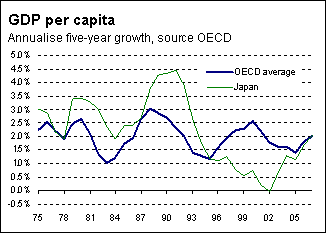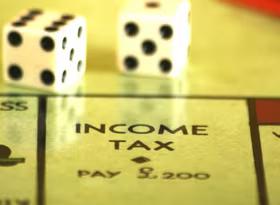Lessons from Japanese crisis management
Lessons from Japanese crisis management
It’s the New Year, with property prices sliding, the stock market down more than 40% from its peak, and the government embarking on a range of economic stimulus initiatives, many of which are of dubious quality. But in this story, the "New Year" isn’t 2009; it’s 1992. And the country isn’t the US or even New Zealand, but Japan.
Japan’s "lost decade" through the 1990s saw both urban land prices and the Nikkei share index eventually bottom out at 75-80% below their peak levels of the early 1990s. Economic growth between 1991 and 1999 averaged just 0.6%pa as the world’s second largest economy stagnated. Japan’s GDP per capita has slipped from sixth in the OECD to 16th since 1993.

Graph 1
The US represents 28% of the global economy, compared to 16% for Japan at the start of the 1990s. So if America were to provide a reprise of Japan’s performance, it would be a bigger handicap for the rest of the world in achieving "normal" economic growth over the next decade. The issue is important for us given New Zealand’s heavy reliance on trade. What’s to stop the US heading down the same path as Japan?
One reason for optimism is the speed and extent of the reaction by the Federal Reserve. The cash rate targeted by the American central bank is now effectively zero. In contrast, Japanese interest rates didn’t get below 1% until 1995, more than five years after the crisis began. With low inflation in Japan, interest rates acted as a significant ongoing constraint on any recovery in economic growth.
Interest rates are not the only lever that central banks use to try and stimulate the economy. Quantitative easing, with the Federal Reserve injecting money into the financial system to try and encourage more lending to take place, is also taking place. Once again, the contrast with Japan is startling – it was not until early this decade that the Bank of Japan accepted that it could do more than simply cutting interstates.
Monetary stimulus is a necessary, but not sufficient, condition to pull the economy out of the financial crisis. Some level of transparency and dynamism in the banking sector is also vital. Looking back over the last 18 months, it can be argued that neither of these traits has been particularly prominent among financial institutions. Revelations of exposure to, and write-offs of, mortgage-backed securities have been delayed as long as possible. But America still beats Japan on this count too. Japanese banks sleepwalked through the 1990s, refusing to call in non-performing loans because they knew it would necessitate recapitalisation and probably result in the loss of control of the bank.
The lack of dynamism in Japan’s banking sector was matched by the stasis of the country’s labour market. The "jobs for life" mindset meant that the unemployment rate took a decade to climb from 2% to 5.5%. These numbers point to an absence of resource reallocation away from unviable businesses, severely limiting the potential for a recovery in economic growth. Again, the contrast with the US is substantial. America’s jobless rate has risen 2 ½ percentage points over the last year, creating a pool of labour resources for new and expanding firms to utilise once economic conditions become more favourable.
Perhaps Japan’s largest mistakes came in the fiscal policy area. Much of the fiscal stimulus packages in the 1990s was aimed at unproductive public works – pork-barrel politics of the highest order. The fiscal watershed occurred in 1997, when the government looked to address its debt problem by increasing taxes. The move proved to be premature, sending the economy back into recession and giving rise to deflation.
Although questions have been asked about the appropriateness of bailing out the banks and the car manufacturers in the US, government officials seem to have pursued a goal of minimising the collateral damage from a full-scale banking sector meltdown or auto industry collapse. In essence, the American approach looks to be minimising the transitional costs of the necessary changes, not trying to completely prevent change from occurring.
Nevertheless, the biggest risks for America probably lie in this area of fiscal policy. If rescue packages start occurring year after year, you know things aren’t right. Each repeated bail-out provides less and less benefit for the economy, with fiscal policy becoming captured by vested interests until the money eventually runs out.
Given the significance of the ongoing financial crisis in the US, the economy could well take five years to get property back on its feet. But in its decade-long struggle, many of Japan’s problems were self-inflicted, with a failure to learn the lessons of the 1930s Great Depression. America was the starting point of the Great Depression, and so should have learnt those lessons. And it need only look at Japan for a refresher course on how not to respond to a banking crisis.





